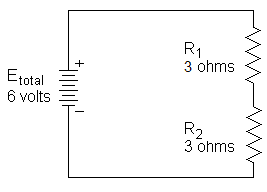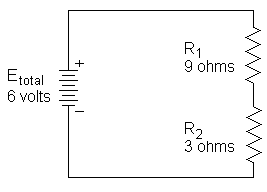Circuit Lab/Solving Resistor Circuits
This is a tutorial page for the event Circuit Lab about solving resistor circuits
The total voltage in the circuit stays the same. Only the voltage used by individual components changes. Here's an example using the formulas for series circuits:
Series Circuits Formulas
Ohm's Law (stated 3 different ways):
[math]\displaystyle{ E = I \times R }[/math]
[math]\displaystyle{ I = E/R }[/math]
[math]\displaystyle{ R = E/I }[/math]
[math]\displaystyle{ E_{total} = E_{R_1} + E_{R_2}.... + E_{R_n} }[/math]
[math]\displaystyle{ R_{total} = R_1 + R_2.... + R_n }[/math]
[math]\displaystyle{ I_{total} = I_{R_1} = I_{R_2}.... = I_{R_n} }[/math]
Circuit 1
To learn everything about this circuit we can use a chart. Start by entering what we know:
Using the formula: R(total) = R1 + R2.... + Rn we can find the total resistance:
We can now use Ohm's Law in the form of I = E/R to find the total current in the circuit
From the formula: I(total) = I(R1) = I(R2).... = I(Rn) we can now determine the current in both resistors:
Lastly, we can use Ohm's Law E = I x R to find the voltage used by each of the resistors
Note: Power (P) is measured in Watts (W). The formula is: P = I x E
Circuit 2
In Circuit 2 resistor #1 is increased to 9 ohms with all other parameters remaining the same. Calculate the values for this circuit just as in Circuit 1. Results are:
Note: The voltage used by resistor 1 increased and the voltage used by #2, the current and total power decreased.









